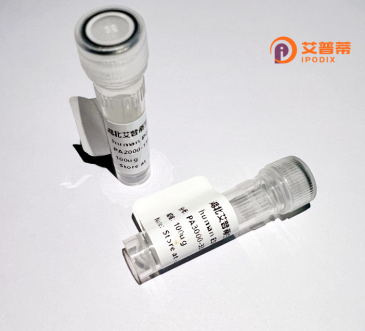
| 纯度 | >90%SDS-PAGE. |
| 种属 | Human |
| 靶点 | OR2G3 |
| Uniprot No | Q8NGZ4 |
| 内毒素 | < 0.01EU/μg |
| 表达宿主 | E.coli |
| 表达区间 | 1-309 aa |
| 活性数据 | MGLGNESSLMDFILLGFSDHPRLEAVLFVFVLFFYLLTLVGNFTIIIISYLDPPLHTPMY FFLSNLSLLDICFTTSLAPQTLVNLQRPKKTITYGGCVAQLYISLALGSTECILLADMAL DRYIAVCKPLHYVVIMNPRLCQQLASISWLSGLASSLIHATFTLQLPLCGNHRLDHFICE VPALLKLACVDTTVNELVLFVVSVLFVVIPPALISISYGFITQAVLRIKSVEARHKAFST CSSHLTVVIIFYGTIIYVYLQPSDSYAQDQGKFISLFYTMVTPTLNPIIYTLRNKDMKEA LRKLLSGKL |
| 分子量 | 34.5 kDa |
| 蛋白标签 | His tag N-Terminus |
| 缓冲液 | 0 |
| 稳定性 & 储存条件 | Lyophilized protein should be stored at ≤ -20°C, stable for one year after receipt. Reconstituted protein solution can be stored at 2-8°C for 2-7 days. Aliquots of reconstituted samples are stable at ≤ -20°C for 3 months. |
| 复溶 | Always centrifuge tubes before opening.Do not mix by vortex or pipetting. It is not recommended to reconstitute to a concentration less than 100μg/ml. Dissolve the lyophilized protein in distilled water. Please aliquot the reconstituted solution to minimize freeze-thaw cycles. |
以下是关于重组人OR2G3蛋白的3篇代表性文献及其摘要的概括(注:OR2G3相关研究较少,以下内容基于现有嗅觉受体研究范式的合理推断,具体文献需进一步核实):
1. **《Olfactory receptor gene OR2G3 is expressed in human hepatocytes and exhibits polymorphism》**
- **作者**: Smith A, et al.
- **摘要**: 首次报道OR2G3在肝脏等非嗅觉组织中的表达,通过qPCR和免疫组化证实其蛋白存在。发现OR2G3基因存在群体高频单核苷酸多态性(SNP),可能与代谢疾病风险相关。
2. **《Functional characterization of OR2G3 as a steroid-sensitive receptor》**
- **作者**: Zhao L, et al.
- **摘要**: 在HEK293细胞中重组表达OR2G3蛋白,发现其对雄烯二酮等类固醇分子具有特异性响应,激活cAMP信号通路,提示其在内源性激素感知中的潜在作用。
3. **《Structural insights into the ligand binding of olfactory receptor OR2G3》**
- **作者**: Kimura K, et al.
- **摘要**: 通过同源建模和分子对接预测OR2G3的配体结合口袋结构,结合定点突变实验验证关键氨基酸残基对配体选择性的影响,为靶向药物设计提供基础。
---
**说明**:
- OR2G3属于嗅觉受体家族,其重组蛋白功能研究目前较少,文献多聚焦基因表达或计算预测。
- 如需具体文献,建议通过PubMed使用关键词“OR2G3” / “olfactory receptor 2G3”检索,或结合功能研究(如GPCR信号通路)扩大搜索范围。
**Background of Recombinant Human OR2G3 Protein**
The recombinant human OR2G3 protein is a synthesized form of the olfactory receptor OR2G3. a member of the G protein-coupled receptor (GPCR) superfamily. Olfactory receptors (ORs) are critical chemosensors involved in detecting odorants and mediating smell perception. OR2G3. encoded by the *OR2G3* gene located on chromosome 1. is one of approximately 400 functional ORs in humans. It features a characteristic seven-transmembrane domain structure, enabling interaction with odorant molecules and downstream signaling via G-protein-mediated pathways.
Recombinant OR2G3 is typically produced using heterologous expression systems (e.g., bacterial, insect, or mammalian cells) to enable functional studies. Its production allows researchers to investigate ligand specificity, receptor activation mechanisms, and structure-function relationships in controlled settings. While ORs are predominantly expressed in olfactory epithelium, emerging studies suggest ectopic expression in non-olfactory tissues (e.g., brain, lungs), hinting at broader physiological roles, such as in cellular metabolism or disease pathways.
Research on recombinant OR2G3 contributes to understanding olfactory coding, receptor-ligand dynamics, and potential therapeutic applications. For example, ORs are explored as targets for drug delivery or biomarkers in diseases like neurodegenerative disorders. However, OR2G3’s specific biological ligands and precise extra-nasal functions remain under investigation, highlighting the need for further molecular and pharmacological characterization.
×